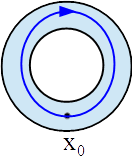This is the second draft of a paper that makes a perhaps surprising connection between the old Platonic notion of a paradigm-universal like ‘the white thing’ and an indefinite superposition state in quantum mechanics. Here is the abstract:
Given an equivalence relation ~ on a set U, there are two abstract notions of an element of the quotient set U/~. The #1 abstract notion is a set S=[u] of equivalent elements of U (an equivalence class); the #2 notion is an abstract entity u_{S} that is definite on what is common to the elements of the equivalence class S but is otherwise indefinite on the differences between those elements. For instance, the #1 interpretation of a homotopy type is an equivalence class of homotopic spaces, but the #2 interpretation, e.g., as developed in homotopy type theory, is an abstract space (without points) that has the properties that are in common to the spaces in the equivalence class but is otherwise indefinite. In philosophy, the #2 abstract entities might be called paradigm-universals, e.g., ‘the white thing’ as opposed to the #1 abstract notion of “the set of white things” (out of some given collection U).
The paper shows how this #2 notion of a paradigm may be mathematically modeled using incidence matrices in Boolean logic and density matrices in probability theory. Then we cross the bridge to the density matrix treatment of the indefinite superposition states in quantum mechanics (QM). This connection between the #2 abstracts in mathematics and ontic indefinite states in QM elucidates Abner Shimony’s literal or objective indefiniteness interpretation of QM.
